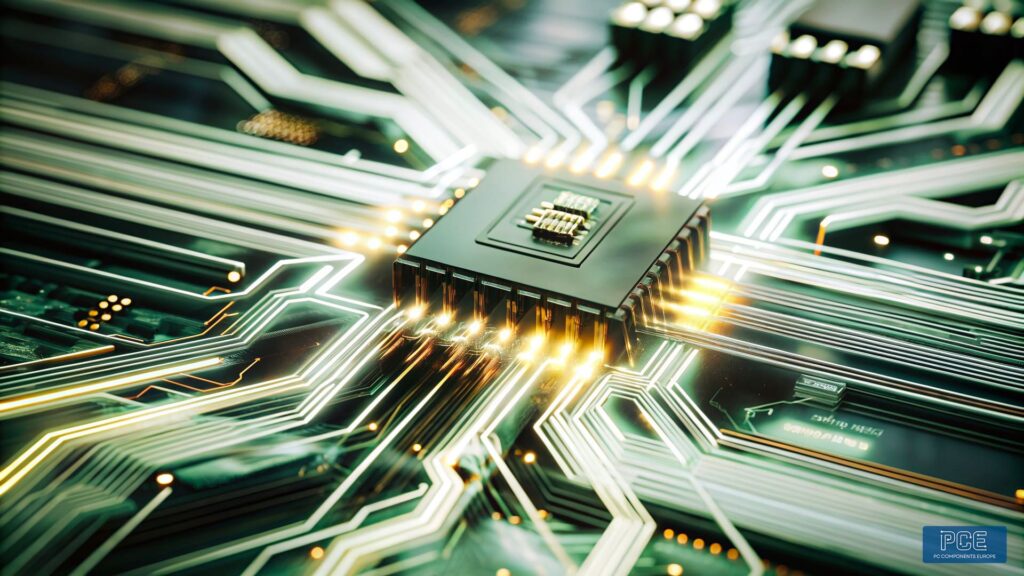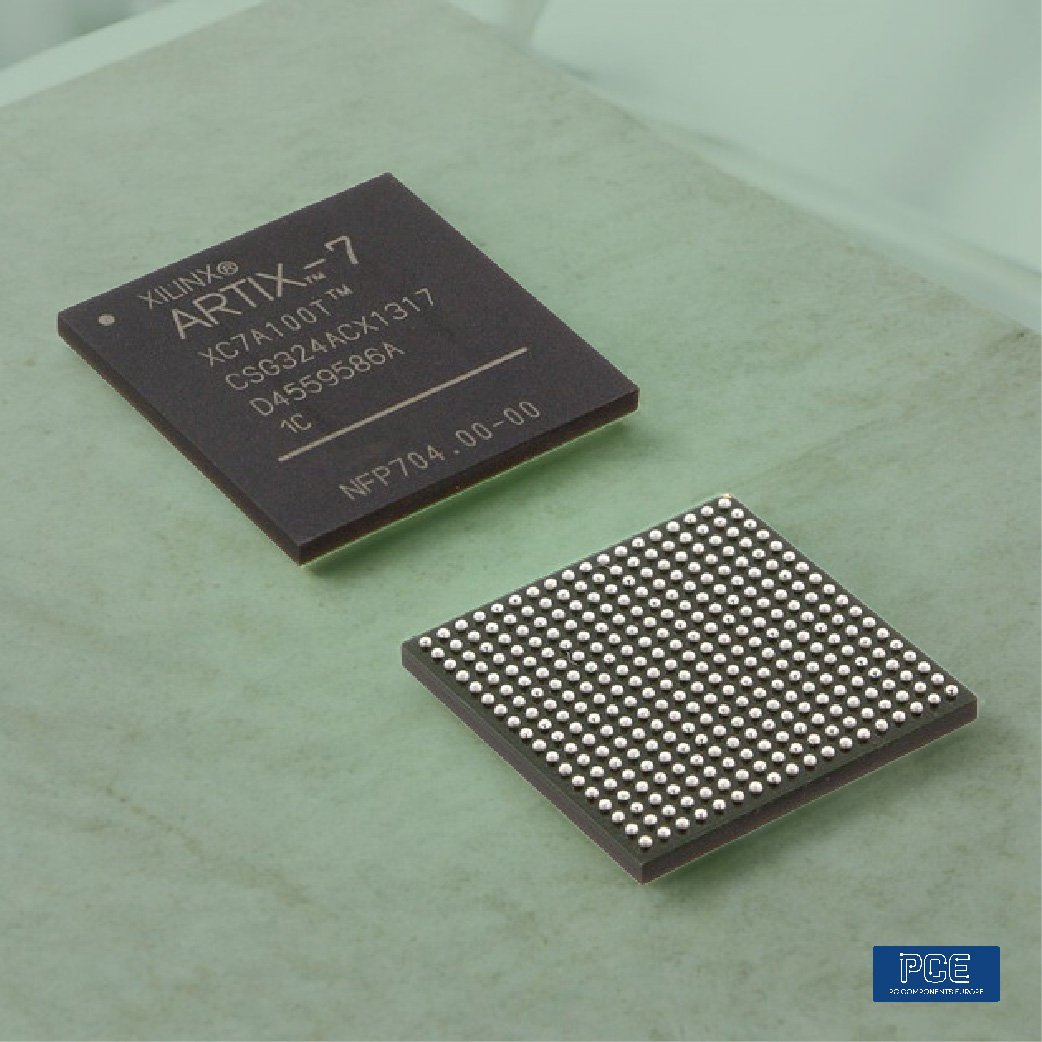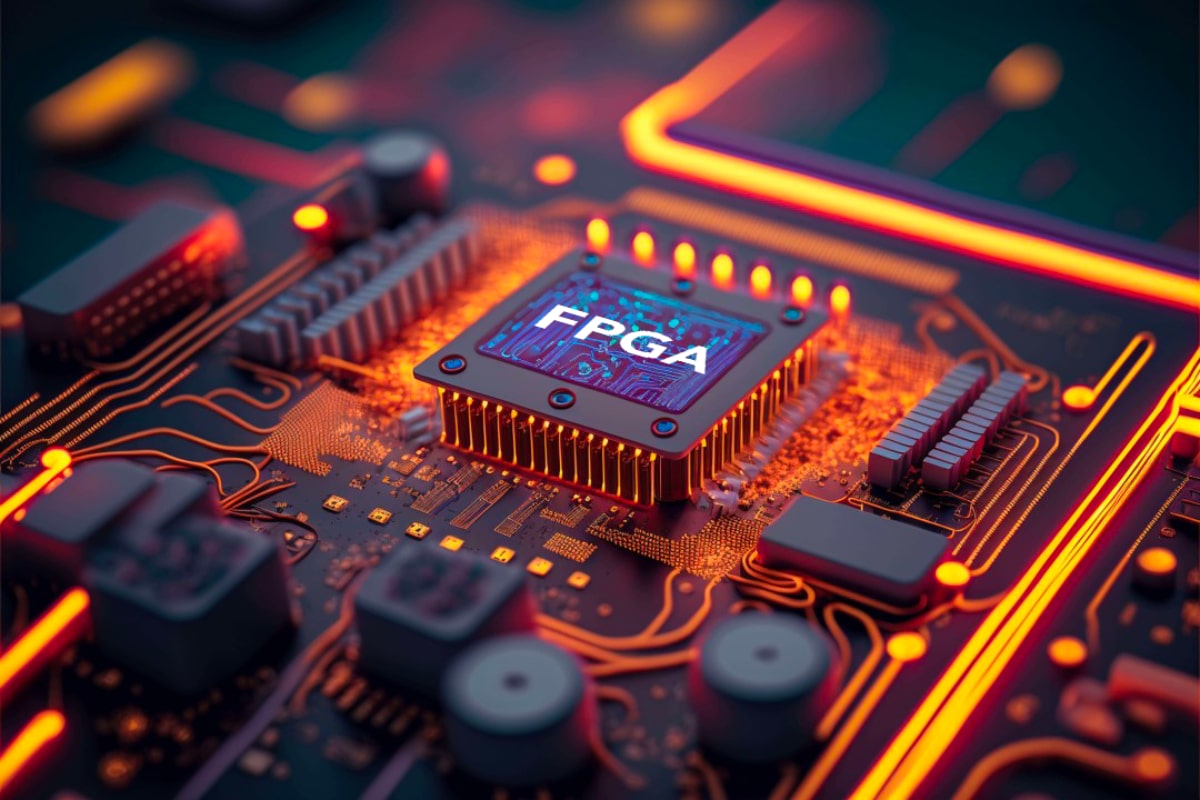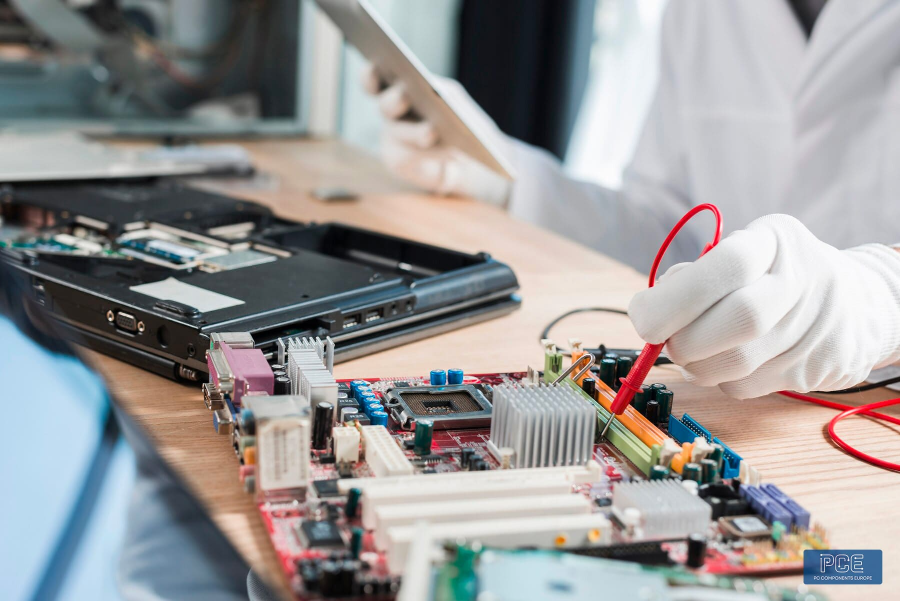Different types of semiconductor devices drive the production of a wide range of applications, from basic gadgets to the most advanced communications systems. Understanding their functions allows us to choose the right components for any type of project or application.
But what exactly is a semiconductor device? In this article, we will not only explain what it is, but we will also go through the six main types and highlight their respective uses with examples.
This will give you an overview of how these components power today's technology and help you choose the ones best suited to your projects.
Keep reading!
What are Semiconductor Devices?
Semiconductor devices are electronic components made from materials with electrical conductivity between that of a conductor (like copper) and an insulator (like glass).
They control the flow of electrical current in devices by leveraging the unique properties of semiconductors, such as silicon or germanium.
These devices are fundamental to modern electronics, as they allow for amplification, switching, and energy conversion in circuits.
In brief, semiconductor devices are electronic parts using semiconductors.
What are semiconductors?
Semiconductors are materials that have electrical conductivity between that of conductors and insulators. This unique property allows them to control electrical current in ways that neither conductors nor insulators can.
In a semiconductor device, small adjustments in voltage or current can result in significant changes in how the device behaves, making them ideal for switching, amplifying signals, and controlling power in electronic systems. These devices are essential in everything from managing power in household appliances to enabling complex data processing in computers and smartphones.
The ability of semiconductor materials to conduct electricity is often modified by adding impurities, a process called doping, which creates regions in the material with different electrical properties.
These regions enable semiconductor devices like diodes and transistors to regulate current, making them the building blocks of modern electronics.
6 Types of Semiconductor Devices and their Applications
- Discrete Devices
Discrete semiconductor devices are individual electronic components with a single function. These are critical building blocks in electronic systems, performing essential operations like switching, amplification, and rectification. Some of the most common discrete devices include:
- Diodes
- Transistor
- Thyristors
- Modules
Let’s learn more about each of these components:
- Diodes
Diodes are one-way electronic valves that allow current to flow in only one direction. Their most common application is rectification, converting AC to DC power. They are used in power supplies, battery chargers, and signal demodulation.- Example: In a power supply circuit, diodes prevent reverse currents, protecting sensitive components from damage.
- Transistor
Transistors are essential for amplifying and switching electronic signals. They come in two main types: bipolar junction transistors (BJTs) and field-effect transistors (FETs). BJTs are often used for amplification, while FETs are preferred for switching applications due to their high efficiency.- Example: Transistors are commonly found in processors, amplifiers, and switches. In a computer’s CPU, transistors are used to process binary data by acting as tiny switches.
- Thyristors
Thyristors are devices that act as bistable switches, conducting when their gate receives a current pulse and continuing to conduct while they remain forward-biased. They are particularly useful in high-power applications like motor speed controls, light dimmers, and pressure control systems.- Example: Thyristors are often used in power electronics, such as in industrial motor drives and AC power control systems.
- Modules
Modules are assemblies of semiconductor devices, typically containing multiple components like diodes, transistors, and thyristors, housed in a single package. These are used in applications where high power and efficiency are necessary, such as inverters and power conversion systems.- Example: Power modules are used in solar inverters to convert DC energy from solar panels into AC power for household use.
2. Optical Devices
Optical semiconductor devices convert electrical signals into light or light into electrical signals. These devices are critical in communication systems, sensors, and display technologies. The primary types of optical devices include:
- Light Emitting Devices (LEDs)
- Photodetectors
- Composite Optical Devices
- Optical communications devices
Light-emitting devices (LEDs)
LEDs generate light when a current passes through them, making them highly efficient for lighting and display technologies. LEDs are widely used for their long life, energy efficiency and environmental benefits. - Example: LEDs are the basis of modern display systems, including those used in TVs, smartphones and advertising screens.
Photodetectors
Photodetectors, such as photodiodes and phototransistors, convert light into electrical signals. They are crucial in sensing applications, such as cameras, optical mice, and solar cells. - Example: Photodetectors are integral to fiber optic communication systems, where they convert incoming light signals back into electrical signals.
Composite Optical Devices
Composite optical devices combine multiple functions, such as detection and emission of light, within a single package. They are essential in complex optical systems where space and performance are key considerations. - Example: In optical data transmission, composite devices can both send and receive light signals, ensuring fast and reliable communication.
Optical Communication Devices
These devices transmit data using light. They are pivotal in high-speed internet systems, data centers, and long-distance communication networks. The speed and efficiency of optical communication devices have revolutionized how data is transmitted globally. - Example: Fiber optic networks use optical communication devices to transmit massive amounts of data at the speed of light, ensuring high-speed internet connections.
3 . Microwave Devices
Microwave semiconductor devices operate at very high frequencies (above 1 GHz) and are used for applications like radar, wireless communications, and satellite broadcasting. These devices can be classified into:
- Discrete microwave devices
- Microwave Integrated Circuits (ICs)
- Microwave Modules
Discrete Microwave
Discrete microwave devices, such as Gunn diodes and IMPATT diodes, are used in generating and amplifying high-frequency microwave signals. These are essential in radar systems and wireless communication technologies. - Example: Gunn diodes are used in police radar to measure the speed of vehicles by generating microwave signals that reflect off moving objects.
Microwave ICs
Microwave ICs integrate multiple functions, such as signal generation, amplification, and filtering, into a single chip. These are used in cell phones, satellite communications systems and military radar systems. - Example: Microwave ICs in mobile phones enable high-frequency transmission and reception of signals, allowing for reliable wireless communication.
Microwave modules
Microwave modules are assemblies that combine multiple microwave components, often including both passive and active elements, into a single package. These modules are used in complex communication systems, where space saving and high performance are essential. - Example: Satellite transponders use microwave modules to amplify and transmit signals back to Earth from space, ensuring clear and uninterrupted communication.
4. Sensors
Sensors are semiconductor devices that detect changes in environmental conditions and convert these changes into electrical signals. Sensors are crucial for applications in automotive systems, healthcare, industrial automation, and consumer electronics.
- Example: In cars, sensors detect parameters like temperature, pressure, and speed, providing essential data to the vehicle’s control systems for smooth operation.
Types of Sensors
- Temperature Sensors: Used in HVAC systems to monitor and control temperature.
- Pressure Sensors: Used in industrial applications to detect pressure changes in liquids or gases.
- Proximity Sensors: Used in consumer electronics like smartphones to detect user proximity and automatically adjust functions such as screen dimming.
5. Integrated Circuits (ICs)
Integrated Circuits (ICs) are semiconductor devices that integrate multiple electronic component, like transistors, diodes, capacitors, and resistors, on a single chip. They have revolutionized modern electronics by enabling more complex and compact designs. The main types of ICs include:
- Memories
- Microprocessors (MPUs)
- Logic ICs
- Analog ICs
Memories
Memory ICs are responsible for storing data. This includes volatile memory (such as RAM) and non-volatile memory (such as Flash memory). These ICs are essential in computers, mobile devices, and any other systems that require data storage.
- Example: Flash memory ICs are used in USB drives and SSDs for fast data storage and retrieval.
Microprocessors (MPUs)
Microprocessors are the brains of modern electronics and control the operations of computers and smartphones. They perform arithmetic and logical operations, allowing devices to execute programs and perform tasks.
- Example : The Intel Core series of microprocessors powers most computers and laptops, handling everything from web browsing to complex calculations.
Logic ICs
Logic ICs perform Boolean operations and are used in devices that require digital decision-making processes. They are vital in systems like digital clocks, calculators, and more complex digital systems like computers.
- Example: Logic ICs are used in computer systems to handle data manipulation and process control tasks.
Analog ICs
Analog ICs handle continuous signals and are used in audio and radio frequency processing. These ICs are often used in sound systems, radio equipment, and sensors.
- Example: Analog ICs in audio amplifiers process sound signals to produce clear and amplified output in home audio systems.
6. Hybrid ICs
Hybrid ICs combine the benefits of multiple semiconductor technologies by integrating different types of components (like transistors, resistors, and capacitors) into one module. These ICs are ideal for applications where standard ICs cannot meet the specific performance or design requirements. Hybrid ICs come in two main forms:
- Thin Membrane Hybrid ICs
- Thick Membrane Hybrid ICs
Thin Membrane Hybrid ICs
These ICs use a thin layer of conductive material, applied through a process called sputtering, to form circuits. They are often used in high-frequency applications and are highly customizable.
- Example: Thin membrane hybrid ICs are used in aerospace systems, where compact size and high reliability are critical.
Thick Membrane Hybrid ICs
Thick membrane ICs use screen printing to apply conductive material. They are typically used in power electronics and other applications where cost-effectiveness and robustness are required.
- Example: Thick membrane hybrid ICs are used in automotive electronics to handle power distribution and control functions.

Find a Wide Range of Electronic Components for Your Projects at PC Components Europe
Discover an extensive selection of diodes, transistors, thyristors, optical devices, microwave devices, sensors, ICs, capacitors, resistors, connectors, power modules, and relays, all available at PC Components Europe to meet your electronic and electromechanical needs.
Some of the components you can find with PCE:
- Diodes
- 1N4148 – Fast Switching Diode (General Purpose)
- 1N5408 – High current rectifier diode
- BAS16 – Surface mounted switching diode
- BYV27-200 – Fast recovery rectifier
2. Transistor
- 2N2222 – General purpose NPN transistor
- 2N2907 – General purpose PNP transistor
- IRF540N – N-channel
- BC547 – Small signal NPN transistor
3.Thyristors
- BT136 – TRIAC for alternating current switching
- 2N5060 – Silicon Controlled Rectifier (SCR)
- TYN612 – SCR for medium power switching
- BTA41-600B – TRIAC for high power applications
4. Optical Devices (LED, Photodetectors)
- CREE-XTEAWT-00-0000-000000H51 – High Power White LED
- LDR-5530 – Photodetector light sensor
- SFH320 – Phototransistor
- OSRAM-LW-W5SM – White LED for lighting
5. Microwave Devices
- MA4E1317 – GaAs microwave diode
- MRF947 – Microwave Transistor
- MAAL-011078 – Microwave amplifier IC
- HMC630LP3E – MMIC GaAs (Microwave Monolithic Integrated Circuit)
6. Sensors
- MPX5010DP – Pressure sensor
- TMP36 – Temperature sensor
- HC-SR04 – Ultrasonic distance sensor
- BH1750 – Ambient light sensor
7. Integrated Circuits (ICs)
- ATmega328P – Microcontroller IC (8-bit, AVR series)
- LM358 – Dual operational amplifier IC
- 74HC595 – Shift register IC
- AD8232 – Heart rate monitoring sensor IC
Click here and discover more about the Top 13 Microcontrollers on the Market
8. Memory IC
- W25Q64JVSSIQ – 64Mb Flash Memory
- AT24C256 – 256Kb EEPROM
- MT48LC16M16A2 – 256Mb SDRAM
- IS25LP064A – Serial Flash Memory (64Mb)
9. Capacitors
- C3225X7R1E106K250AB – Multilayer Ceramic Capacitor, 10 µF
- EEU-FR1V102 – Electrolytic capacitor, 1000 µF, 35V
- B43504A5477M000 – Plug-in electrolytic capacitor, 470 µF, 450V
10. Resistors
- CRCW080510K0FKEA – SMD Resistor, 10kΩ, 1%
- RS1/4-1K – Feedthrough carbon film resistor, 1kΩ
- Y ageo RC0402FR-071KL – 1kΩ SMD Resistor, 1% Tolerance, 0402
- Vishay VR68000001005FA100 – Precision Wire Resistor, 100Ω
11. Connectors
- TE 282836-4 – 4 position wire to board connector
- Molex 39-30-3040 – 4 position header
- JST XH-2P – 2 pin connector
- Amphenol 97-3106A-14S-6 P – Circular connector
12. Power Modules
- IRAMS10UP60B – Intelligent Power Module (IPM), 600V
- FOD8316 – Driver optocoupler for IGBT
- SPM3A60D – Motor power module, 600V
- PM25CLB060 – IGBT module, 25A
13. Relay
- G2R-1-E-DC24 – General purpose relay, SPDT, 24V DC
- G6A-234P-ST-US-DC12 – Signal relay, 12V DC
- HF115F – Power relay, 12V DC, 30A
- Omron LY2-DC12 – 12V DC relay, DPDT
Semiconductor Devices Are at The Core of Modern Technology
They enable everything from smartphones to space exploration. Understanding the six major types of discrete devices, optical devices, microwave devices, sensors, ICs, and hybrid ICs, will help you make informed decisions when choosing components for your projects.
As you have read in this article, each of these devices has unique characteristics and applications, making them indispensable in a wide range of industries.
Do you have questions or want to find a specific semiconductor device?
Contact our PC Components team today!
References :
“Semiconductor Devices: Physics and Technology” by SM Sze
“Introduction to Semiconductor Devices” by Kevin F. Brennan
Toshiba Electronic Devices & Storage Corporation



